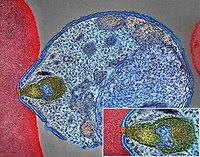
Photo from wikipedia
Human malaria due to zoonotic transmission has been recorded in the Atlantic Forest, an extra-Amazonian area in Brazil, which are a challenge for malaria control. Naturally acquired humoral immune response… Click to show full abstract
Human malaria due to zoonotic transmission has been recorded in the Atlantic Forest, an extra-Amazonian area in Brazil, which are a challenge for malaria control. Naturally acquired humoral immune response against pre-erythrocytic and erythrocytic antigens of Neotropical primates (NP) was evaluated here to improve the knowledge about the exposure of those animals to the malaria transmission and support the identification of the potential reservoirs of the disease in the Atlantic Forest. Blood samples of 154 monkeys from three areas of the Atlantic Forest were used to identify IgG antibodies against peptides of the repeat region of the major pre-erythrocytic antigen, the circumsporozoite protein (CSP), of Plasmodium vivax (PvCSP), Plasmodium brasilianum/Plasmodium malariae (Pb/PmCSP), and Plasmodium falciparum (PfCSP) by ELISA. Antibodies against erythrocytic recombinant antigens of P. vivax, Apical membrane antigen 1 (PvAMA-1), Erythrocyte binding protein 2 (PvEBP-2) and domain II of Duffy binding protein (PvDBPII) were also evaluated. Parameters, such as age, sex, PCR positivity, and captivity, potentially associated with humoral immune response were analyzed. Eighty-five percent of NP had antibodies against at least one CSP peptide, and 76% against at least one P. vivax erythrocytic antigen. A high percentage of adults compared to non-adults were seropositive and showed increased antibody levels. Neotropical primates with PCR positive for P. simium had a significantly higher frequency of positivity rate for immune response against PvEBP-2, PvDBPII and also higher antibody levels against PvDBPII, compared to PCR negative NPs for this species. Monkeys with PCR positive for P. brasilianum/P. malariae showed higher frequency of seropositivity and antibody levels against Pb/PmCSP. Levels of antibodies against Pb/PmCSP, PvEBP-2 and PvDBPII were higher in free-living than in captive monkeys from the same area. All Platyrrhine families showed antibodies against CSP peptides, however not all showed IgG against erythrocytic antigens. These findings showed a high prevalence of naturally acquired antibodies against CSP repeats in all studied areas, suggesting an intense exposure to infected-mosquitoes bites of NP from all families. However, mainly monkeys of Atelidae family showed antibodies against P. vivax erythrocytic antigens, suggesting blood infection, which might serve as potential reservoirs of malaria in the Atlantic Forest.
Journal Title: Frontiers in Cellular and Infection Microbiology
Year Published: 2021
Link to full text (if available)
Share on Social Media: Sign Up to like & get
recommendations!